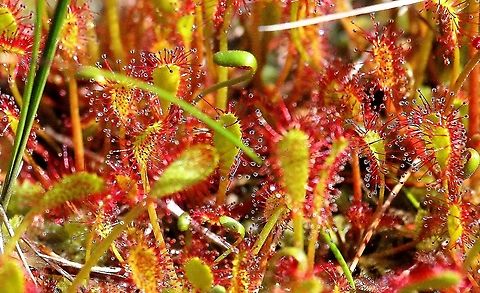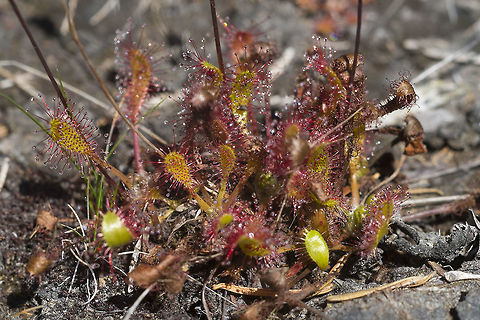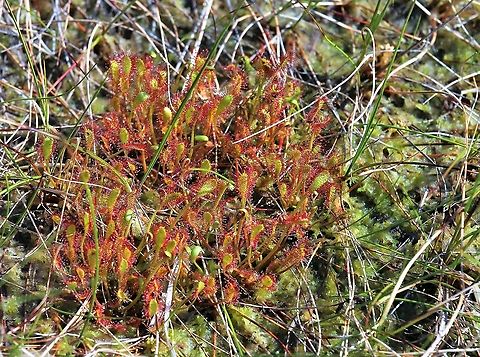
Appearance
''Drosera anglica'' is a perennial herb which forms an upright, stemless rosette of generally linear-spatulate leaves.As is typical for sundews, the laminae are densely covered with stalked mucilaginous glands, each tipped with a clear droplet of a viscous fluid used for trapping insects. The lamina, which is 15–35 millimetres long, is held semi-erect by a long petiole, bringing the total leaf size to 30–95 mm.
Plants are green, coloring red in bright light. In all populations except those in Kaua'i, ''D. anglica'' forms winter resting buds called hibernacula. These consist of a knot of tightly curled leaves at ground level, which unfurl in spring at the end of the dormancy period.
The root system is weak and penetrates only a few centimeters, serving mainly as an anchor and for water absorption. Nitrogen is in short supply in bogs and trapping and digesting insects provides an alternate source.
''Drosera anglica'' flowers in the summer, sending up peduncles 6–18 centimetre. Long bearing several white flowers which open individually. Like other sundews, the flowers have five sepals, petals, and stamens. The petals for this species are 8–12 mm long, and the flowers have branched 2-lobed styles.
The odorless, nectar-less flowers do not rely on insect pollinators for pollination, rather setting seed well through self-pollination. The black ovoid seed forms in a dehiscent capsule and is 1 to 1 1⁄2 mm long.

Distribution
''Drosera anglica'' is one of the most widely distributed sundews in the world. It is generally circumboreal, meaning that it is found at high latitudes around the globe.In a few areas, however, it is found farther south, particularly in Japan, southern Europe, the Hawaiian island of Kauaʻi, and California. Plants from Hawaiʻi, where it is known as ''mikinalo'', are generally smaller than normal and do not experience a winter dormancy period.
Its natural habitat includes 12 U.S. states, including Alaska, and 11 Canadian provinces and territories. The altitudinal range is from 5 m to at least 2000 m.

Habitat
''Drosera anglica'' grows in open, non-forested habitat with wet, often calcium-rich soils. These include bogs, marl fens, quaking bogs, cobble shores, and other calcareous habitats.This tolerance of calcium is relatively rare in the rest of the genus. ''D. anglica'' is often associated with various sphagnum mosses, and many times grows in a soil substrate that is entirely composed of living, dead, or decomposed sphagnum.
The sphagnum wicks moisture to the surface while simultaneously acidifying it. What soil nutrients are not seeped away by the constant moisture are often used up by the sphagnum or made unavailable by the low soil pH. Since nutrient availability is low, competition from other plants is diminished, allowing the carnivorous English sundew to flourish.
References:
Some text fragments are auto parsed from Wikipedia.